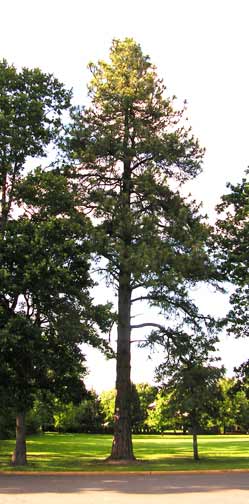 |
Previous Issues |
| Cedar Mill Community Website |
|
| About Cedar Mill News |
|
||||||
| Volume 4, Issue 6 | June
2006
|
|||||
The Nature of Cedar Mill
|
 |
| Here's a ponderosa in Terra Linda Park, however this may not be a true Valley Ponderosa |
Ponderosas typically grow on drier sites, with shallow or no slope, and prefer lots of sun. They do well in moderately drained soils, but can survive in finer, silty soils. Individual trees can be seen towering above a forest, but usually these originally grew out in the open and the forest later grew up around them. They are often seen in oak savannas or woodlands and many of the same animals that prefer oaks will take advantage of the pines for habitat, food, and refuge. For example, western gray squirrels feed on the pine seeds and nest in the branches, and hawks and owls use the high crowns of the pines for nesting and perching points.
Botanical archeologists have identified pollen from our ponderosa pines several thousand years old and, based upon the pollen counts in soil core samples, have estimated the ponderosa populations peaked and held steady for about 7,000 years, until settlers from east of the Rockies moved into Oregon in the mid-1800’s.
The Latin name ‘ponderosa’ means ‘heavy (for the wood), and indicates why ponderosas have been prized for timber from the earliest times of Oregon settlement. The grain is typically straight and free of defects in a healthy stand. The wood is durable and has natural decay resistance that makes it an excellent wood for construction and finish carpentry. In fact, these traits led to the decline of the valley’s ponderosas over the last 150 years.
Today, the Willamette Valley Ponderosa Pine Conservation Association (westernforestry.org/wvppca/index.htm) actively promotes seed collection from trees and stands throughout the valley to provide native source seedlings for replanting. If you are looking for a tree that will achieve a grand height and add wonderful character to both your yard and your neighborhood, a Willamette Valley ponderosa pine is a fine choice.
Here's a list of the 2005 Seedling Nurseries that carried Willamette Valley Ponderosa seedlings. They may or may not have them this year. Remember, fall is the best time to plant a tree! (Word doc, 40Kb) And please note: this will grow to be a very large tree that may drop lots of needles and cones.
If you're interested in finding out more about these trees, you can contact Bob McNitt at pineguy@att.net or (503) 769-9806
Cedar Mill Business Association
Published monthly by Cedar Mill Advertising & Design
Publisher/Editor:Virginia
Bruce
503-629-5799
12110 NW West Rd
Portland, OR 97229